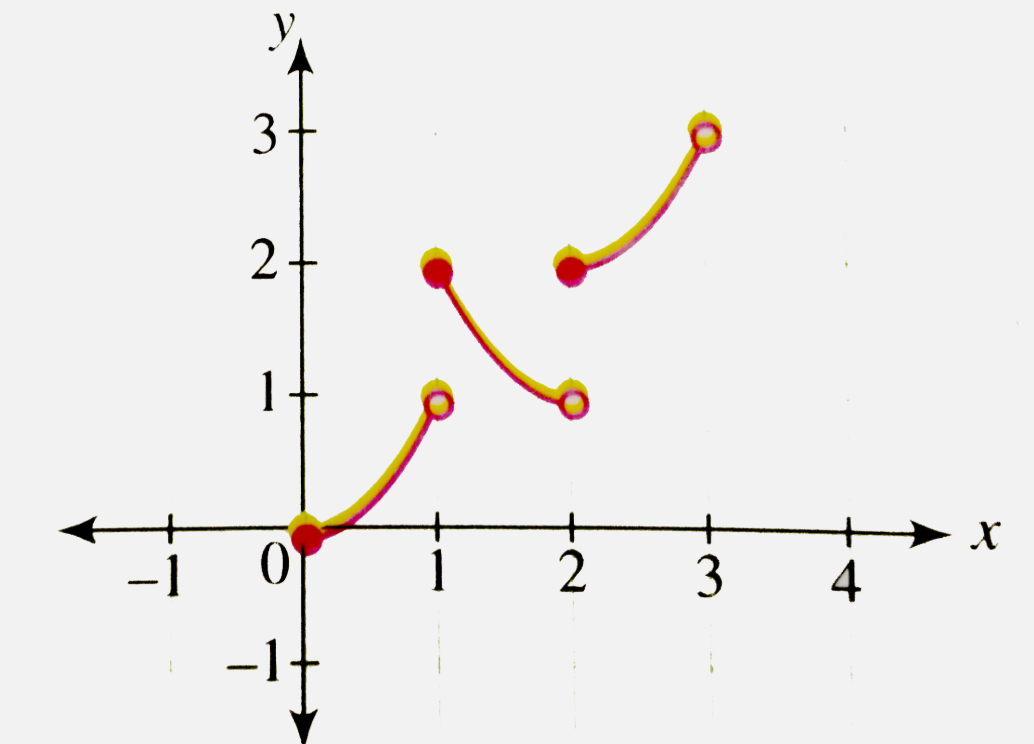Let f:R→R be a continuous onto function satisfying f(x)+f(−x)=0∀x∈R. If f(−3)=2andf(5)=4∈[−5,5], then the minimum number of roots of the equation f(x)=0 isSolution in Tamil
f(x)+f(−x)=0
f(x) is an odd function.
Since the points (-3, 2) and (5, 4) lie on the curve, (3, -2) and (-5, -4) will also lie on the curve.
For minimum number of roots, graph of the continuous function f(x) is as follows.

From the above graph of f(x), it is clear that equation f (x) = 0 has at least three real roots.
Topper's Solved these Questions
- BOOK - CENGAGECHAPTER - GETTING STARTED WITH GRAPHSEXERCISE - Exercise18videos
GETTING STARTED WITH GRAPHS
- BOOK - CENGAGECHAPTER - FUNCTIONSEXERCISE - Question Bank21videos
FUNCTIONS
- BOOK - CENGAGECHAPTER - GRAPH OF INVERSE TRIGONOMETRIC FUNCTIONSEXERCISE - Exercise18videos
GRAPH OF INVERSE TRIGONOMETRIC FUNCTIONS
Similar Questions
Does the following graph pass the vertical or horizontal line test ?
 04:42View Solution
04:42View SolutionIf there are four distinct real numbers satisfying thẻ equation ∣∣x2−4x−7∣∣=n, then number of integers in the range of n is
05:12View SolutionDraw the graph of y=tan−1x+cot−1x
View SolutionLet f:R→R be a continuous onto function satisfying f(x)+f(−x)=0∀x∈R. If f(−3)=2andf(5)=4∈[−5,5], then the minimum number of roots of the equation f(x)=0 is
View SolutionLet f:R rarr R be a continuous onto function satisfying f(x)+f(-x)=0AA x in R, If f(-3)=2 and f(5)=4 in [-5,5], then the equation f(x)=0 has
02:15View SolutionLet f:R→R be a continuous onto function satisfying f(x)+f(−x)=0,∀x∈R . If f(−3)=2andf(5)=4 in [-5, 5], then what is the minimum number of roots of the equation f(x) = 0?
06:23View SolutionLet a function f:R→R, where R is the set of real nos. satisfying the equation f(x+y)=f(x)+f(y)∀x,y if f(x) is continuous at x = 0, then
05:00View SolutionLet f(x) be a continuous & differentiable function on R satisfying f(−x)=f(x)&f(3+x)=f(3−x)∀x∈R. If f'(1)=−5 then f'(7) =
04:52View SolutionLet f:R→R be a continuous onto function satisfying f(x)+f(−x)=0∀x∈R. If f(−3)=2 and f(5)=4 in [−5,5], then the minimum number of roots of the equation f(x)=0 is
06:16View SolutionLet f(x) be continuous functions f:R→R satisfying f(0)=1andf(2x)−f(x)=x. Then the value of f(3) is 2 b. 3 c. 4 d. 5
05:12View SolutionLet f:R→R be a continuous onto function satisfying f(x)+f(−x)=0,∀x∈R . If f(−3)=2andf(5)=4 in [-5, 5], then what is the minimum number of roots of the equation f(x) = 0?
02:12View SolutionLet f(x) be continuous functions f:R→R satisfying f(0)=1andf(2x)−f(x)=x. Then the value of f(3) is 2 b. 3 c. 4 d. 5
04:14View SolutionLet a function f: R to R , where R is the set of real nos. satisfying the equation f(x+y) = f(x) + f(y) AA x, y if f(x) is continuous at x = 0, then
03:08View Solutionएक सतत् एवं आच्छादक फलन f:R→R इस प्रकार से है कि f(x)+f(−x)=0,∀x∈R. यदि f(-3)=2 तथा f(5)=4 तो अन्तराल [-5,5], में f(x)=0 का-
02:32View SolutionLet f:R→R be a function satisfying f(2−x)=f(2+x)andf(20−x)=f(x)∀x∈R.For this functions f. answer the following
The graph of y = f(x) is not symmetrical about03:32View SolutionLet f: R→R be a function defined as f (x) = 3x+ 7 , x∈R . Show that f is an onto functions.
04:07View Solution

